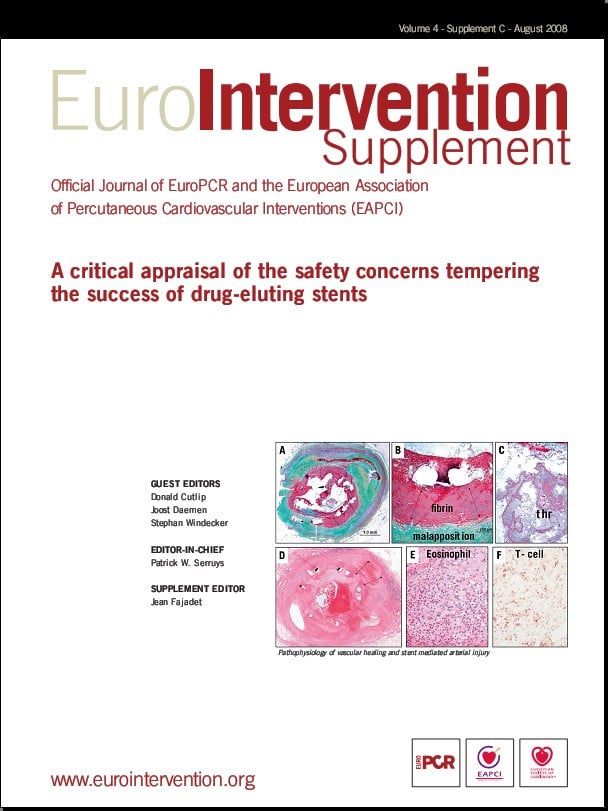Abstract from the Ontario registry
Abstract
Background: The placement of drug-eluting stents decreases the frequency of repeat revascularisation procedures in patients undergoing percutaneous coronary intervention (PCI) in randomised clinical trials. However, there is uncertainty about the effectiveness of drug-eluting stents, and increasing concern about their safety, in routine clinical practice.
Methods: From the Cardiac Care Network of Ontario’s population-based clinical registry of all patients undergoing PCI in Ontario, Canada, we identified a well-balanced cohort of 3751 pairs of patients, matched on the basis of propensity score, who received either bare-metal stents alone or drug-eluting stents alone during an index PCI procedure between December 1, 2003, and March 31, 2005. The primary outcomes of the study were the rates of target-vessel revascularisation, myocardial infarction, and death.
Results: The 2-year rate of target-vessel revascularisation was significantly lower among patients who received drug-eluting stents than among those who received bare-metal stents (7.4% vs. 10.7%, P<0.001). Drug-eluting stents were associated with significant reductions in the rate of target-vessel revascularisation among patients with two or three risk factors for restenosis (i.e., presence of diabetes, small vessels [<3 mm in diameter], and long lesions [20 mm]) but not among lower-risk patients. The 3-year mortality rate was significantly higher in the bare-metal-stent group than in the drug-eluting-stent group (7.8% vs. 5.5%, P<0.001), whereas the 2-year rate of myocardial infarction was similar in the two groups (5.2% and 5.7%, respectively; P=0.95).
Conclusions: Drug-eluting stents are effective in reducing the need for target-vessel revascularisation in patients at highest risk for restenosis, without a significantly increased rate of death or myocardial infarction.
(N Engl J Med 2007 357:1393-1402) © [2007] Massachusetts Medical Society. All rights reserved.
Acknowledgement
Reprinted from The New England Journal of Medicine
Volume 357:1393 October 4, 2007 Number 14
with permission from Massachusetts Medical Society
Commentary on the Ontario registry
With the enthusiastic adoption of drug-eluting stents (DES) for a wide variety of clinical settings and anatomic situations and emerging serious concerns about late stent thrombosis, several registry studies have been dedicated to compare the long-term effectiveness and safety of DES with bare-metal stents (BMS). This study is based on a prospective clinical registry in Ontario with parallel groups of patients receiving either DES or BMS according to ill-defined criteria. Although the randomised trial is the ideal method for measuring treatment effects between DES vs. BMS, such studies are often confined to highly selected patients and have provided an answer to treatment effect under restricted conditions (“on-label” use). Obviously, well-designed observational studies provide valuable information to evaluate effectiveness and “real” safety under routine clinical practice.
Among the controversial reports regarding the long-term risks and benefits of DES relative to BMS, investigators examined data from a prospective clinical registry of all percutaneous coronary interventions (PCI) in Ontario and reported the two-year results based on 3,751 propensity-matched cohort after rigorously adjusting the possible predictors for outcomes. The primary finding of the effectiveness of DES is that use of DES is more effective with significant reduction of target-vessel revascularisation (TVR) than BMS (7.4% vs. 10.7%, P<0.001). The greatest reductions in TVR were pronounced in complex patients and lesion subsets with diabetes, small vessel disease (diameter <3 mm), or long lesions (length >20 mm). In contrast to the immediate preceding data from the large population in Sweden (SCAAR registry) which sounded the alarm for unrestricted DES use, long-term mortality at the 2-year was slightly but significantly higher in the BMS recipients than in the DES recipients (7.8% vs. 5.5%, P<0.001). These results are similar to a series of recent large registry analyses (Massachusetts, Western Denmark, S.T.E.N.T., NHLBI, New York State registries, etc.) comparing DES vs. BMS that have emerged over the last year, and which have provided some reassurance regarding the long-term safety of DES. These conflicting findings may derive from the different penetration rate of DES use, different selection strategy of DES, diverse duration of clopidogrel use, and degree of bias exclusion.
In this analysis of a large, population-based database, the simple, but meaningful message is that DES were more effective than BMS at reducing TVR, especially in high-risk patents and lesions subsets, with no significant “penalty” such as an increase in risk for death or myocardial infarction. However, most of recent evidence support that there are more late thrombosis over times in DES recipients than in BMS recipients. Therefore, considering the clinical and anatomic features of coronary disease (terms as “high-risk patients” or “low-risk patients”), this study suggests that selective and well-defined use of DES may be mostly beneficial and optimal strategy in the current PCI situations.
Further investigation to (1) define the optimal duration of clopidogrel use, (2) evaluate the long-term safety through large, long-term, randomised trials, and (3) develop more smart and safe DES platforms without thrombotic vulnerability, is currently necessary.

